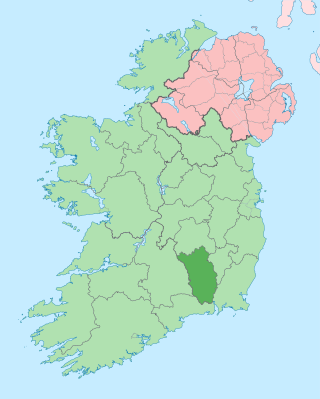
County Kilkenny is a county in Ireland. It is in the province of Leinster and is part of the Southern Region. It is named after the city of Kilkenny. Kilkenny County Council is the local authority for the county. At the 2022 census the population of the county was 103,685. The county was based on the historic Gaelic kingdom of Ossory (Osraighe), which was coterminous with the Diocese of Ossory.
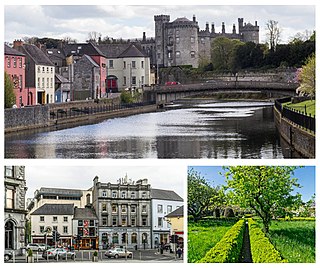
Kilkenny is a city in County Kilkenny, Ireland. It is located in the South-East Region and in the province of Leinster. It is built on both banks of the River Nore. The 2022 census gave the population of Kilkenny as 27,184, the thirteenth-largest urban center in Ireland.
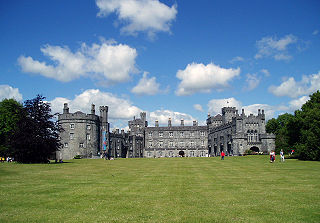
Kilkenny Castle is a castle in Kilkenny, Ireland, built in 1260 to control a fording-point of the River Nore and the junction of several routeways. It was a symbol of Norman occupation, and in its original 13th-century condition, it would have formed an important element of the town's defences with four large circular corner towers and a massive ditch, part of which can still be seen today on the Parade.
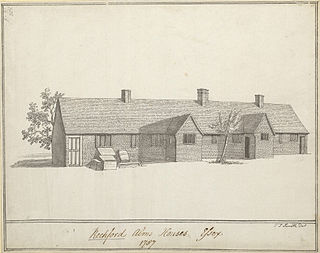
An almshouse is charitable housing provided to people in a particular community, especially during the Middle Ages. They were often targeted at the poor of a locality, at those from certain forms of previous employment, or their widows, and at elderly people who could no longer pay rent, and are generally maintained by a charity or the trustees of a bequest. Almshouses were originally formed as extensions of the church system and were later adapted by local officials and authorities.

Castlepollard is a village in north County Westmeath, Republic of Ireland. It lies west of Lough Lene and northeast of Lough Derravaragh and Mullingar.
The architecture of Ireland is one of the most visible features in the Irish countryside – with remains from all eras since the Stone Age abounding. Ireland is famous for its ruined and intact Norman and Anglo-Irish castles, small whitewashed thatched cottages and Georgian urban buildings. What are unaccountably somewhat less famous are the still complete Palladian and Rococo country houses which can be favourably compared to anything similar in northern Europe, and the country's many Gothic and neo-Gothic cathedrals and buildings.
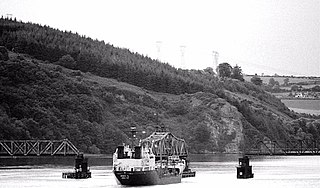
Barrow rail bridge,, is a pratt truss type of railway bridge that spans the river Barrow between County Kilkenny and County Wexford in the south east of Ireland. This rural landmark with a length of 2,131 ft (650 m) is the longest bridge on the river. It was second longest bridge in Ireland and the third longest rail bridge on the islands of Ireland & Great Britain. Designed by Sir Benjamin Baker and built by the firm of Sir William Arrol. It is known locally as Barrow Bridge.

Rothe House is a late 16th-century merchant's townhouse complex located in the city of Kilkenny, Ireland. The complex was built by John Rothe Fitz-Piers between 1594–1610 and is made up of three houses, three enclosed courtyards, and a large reconstructed garden with orchard. As a museum, it is accessible to the public.

Freshford is a village and former town in the barony of Crannagh, County Kilkenny, Ireland. It is 13 km north-west of Kilkenny city.
Scott Tallon Walker is an architecture practice with its head office in Dublin, Ireland and further offices in London, Galway and Cork. It is one of the largest architecture practices in Ireland. Established in 1931 as Scott and Good, becoming Michael Scott Architect in 1938, and Michael Scott and Partners in 1957 before changing to the current Scott Tallon Walker in 1975. Scott Tallon Walker and its earlier incarnations developed a reputation for modernism.
The Mayor of Kilkenny is an honorific title used by the head of Kilkenny Borough Council. The Council has jurisdiction throughout its administrative area which is the city of Kilkenny in the Republic of Ireland. The office was established in the 16th century and had significant powers. The office was all but abolished under the Local Government Act 2001. All that remains of the office, per section 11 of the Act is a symbolic role: "Subject to this Act, royal charters and letters patent relating to local authorities shall continue to apply for ceremonial and related purposes in accordance with local civic tradition but shall otherwise cease to have effect.". The Act goes on to state the chairman of the Council must be styled the Cathaoirleach and that "Any reference in any other enactment to the lord mayor, mayor, chairman, deputy lord mayor, deputy mayor or vice-chairman or cognate words shall, where the context so requires, be read as a reference to the Cathaoirleach or Leas-Chathaoirleach or other title standing for the time being.".
Tholsel was a name traditionally used for a local municipal and administrative building used to collect tolls and taxes and to administer trade and other documents in Irish towns and cities. It was at one stage one of the most important secular buildings in Ireland's town and cities and the level of importance was reflected in the prominence and size of these buildings as well as the expensive materials and architectural techniques used. Some historic tholsels still exist, notably The Tholsel, Kilkenny. Towards the end of the 18th century the term tholsel was typically swapped for Market House with many of the administrative functions of the original tholsel transferring to another dedicated local council or government building such as a court or sessions house.

Wandesford House is an eighteenth-century almshouse in the centre of York, England, one of twelve still-functioning almshouses in the city, and the oldest still in its original building. Built in 1739 and opened in 1743, the house is an important example of the classical style in the city. Like many historic almshouses, it was referred to as a hospital before that term became chiefly associated with medical establishments.
Davis Ducart, was an architect and engineer in Ireland in the 1760s and 1770s. He designed several large buildings and engineering projects. He had associations with the canal builders of the time and the mining industry and worked on many projects in the County Tyrone coalfield.
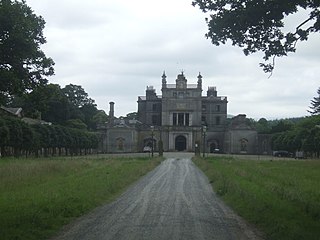
Curraghmore near Portlaw, County Waterford, Ireland, is a historic house and estate and the seat of the Marquess of Waterford. The estate was part of the grant of land made to Sir Roger le Puher by Henry II in 1177 after the Anglo-Norman invasion of Ireland. Since then, the De La Poer Beresford family has owned these estates. It is the oldest family home in Ireland.
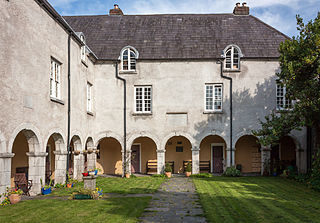
Skiddy's Almshouse is the oldest inhabited building in the city of Cork. It was built in 1718 and finished in 1719.
Sir Richard Shee was an Irish lawyer, politician, and Deputy Lord Treasurer of Ireland. He was a prominent member of the ruling class in Kilkenny city. He is best remembered for his influence on the architecture of Kilkenny city through his founding of the Shee Alms House in Rose Inn Street, Kilkenny, and for his ornate tomb in Saint Mary's Church.
Frank Murphy (1916–1993) was an Irish architect. Born in Cork, he was active mainly in the 1950s and 1960s, and his works include a number of modernist structures. In a 2018 editorial in the Irish Examiner, Murphy was described as "arguably Cork's most eminent and exciting modern architect", and as "Cork's unsung hero of Modernism".












